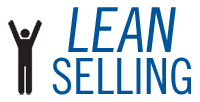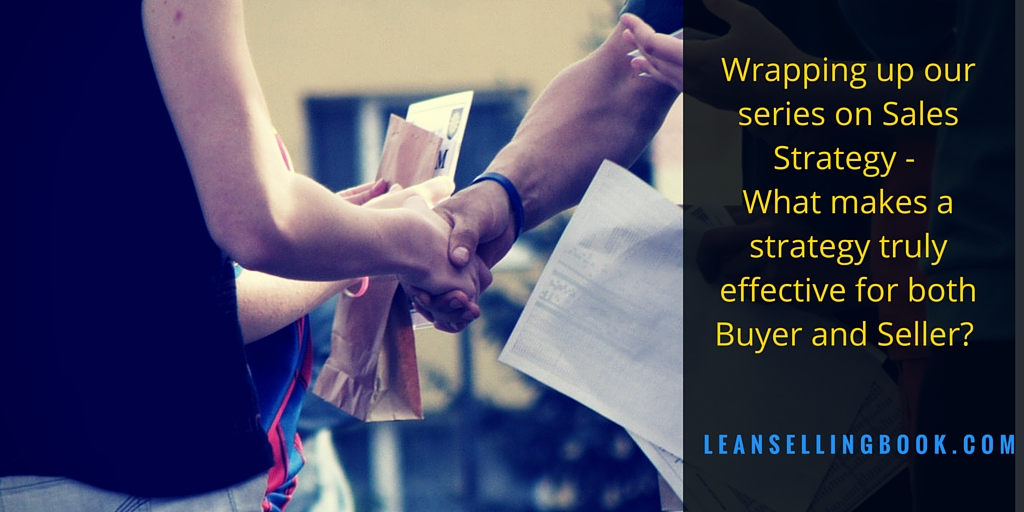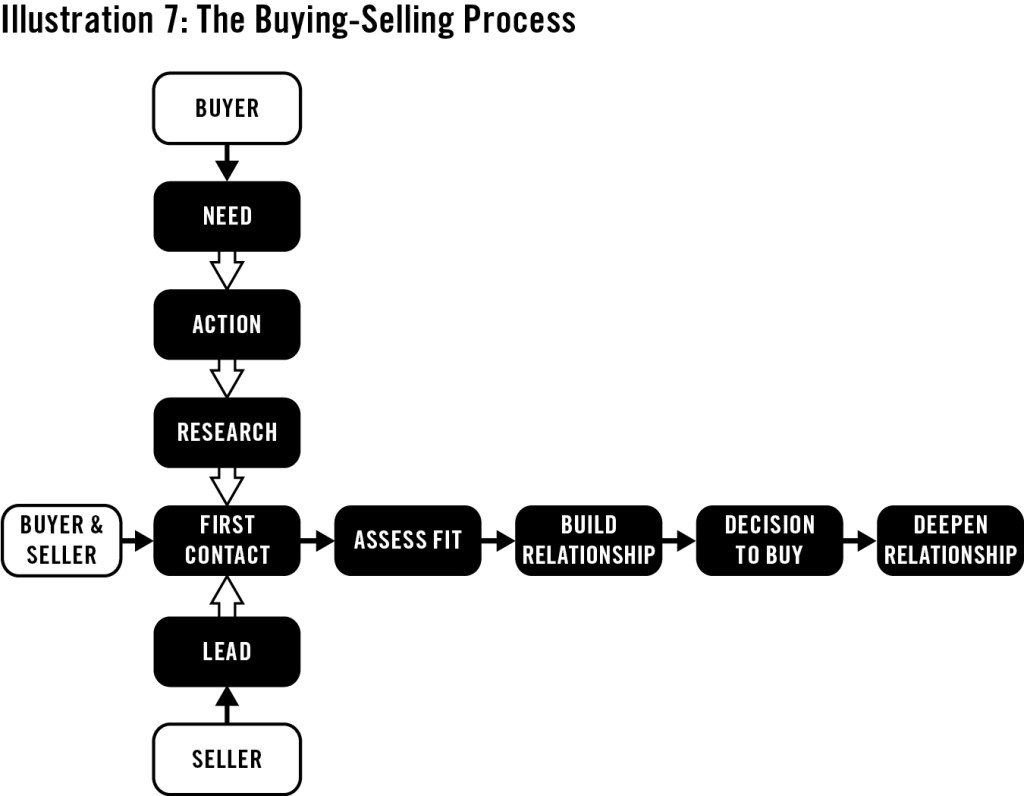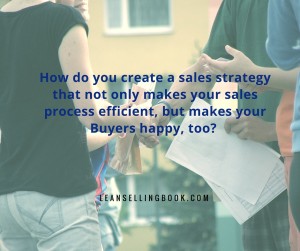Create the Sales Strategy You Want
Part Three: The Ideal Sales Strategy
We first looked at the Seller’s perspective, following Mike from SEL as he went through the sales process with Jim, from BUY. Mike lost out and when we followed Jim through the same journey last week, we got a glimpse into the reasons why. With a view from both perspectives, the question is how this might affect your overall sales strategy. This week we’ll be looking at Jane’s Lean Selling approach, where she takes a higher level view of the process while keeping both perspectives in mind. What Jane does is different enough to not just make a sale, but a larger one to boot.
The key difference between Jane’s process and Mike’s is that his had only one participant: Mike. Jane’s process has two: the Buyer and her. Does your current sales strategy incorporate both participants, or is it focused on the Seller alone?
Jane’s process begins before BUY ever enters the equation. She evaluates her current pipeline and realizes she needs to add more leads to keep her pipeline at its target levels. Jane is looking to take on new prospects when Jim calls, and volunteers to call him back.
The call with Jim leads to the first step of her joint process, First Contact. Since Jane is bringing several new leads into her pipeline, she keeps initial calls brief and on-point, just enough to assess the fit of each lead. Jim is one of several leads, but Jane makes sure not to treat him that way.
Take a look at the illustration below.* This details Jane’s process and the path she and her Buyer take—compare it to a traditional sales process or Buyer’s journey. Both Buyer and Seller have to be engaged once First Contact has been initiated, and both collaborate together throughout the remainder of the journey.
Jane keeps the call with Jim focused on his requirements. This serves two purposes, which benefits both parties. It keeps Jane’s time investment low until she can assess the fit, and it makes Jim feel each call with her is productive. By feeling that he’s not wasting his time taking Jane’s calls, Jim’s building a trusting relationship with her. Jane also has time to repeat the same process with her other prospects.
At this point in the shared process Jane and Jim are both assessing fit. She is being efficient with her questions, using them to address specific qualifiers. While the phrasing is different for each prospect, the answers will help Jane identify how qualified they are and how ready they are to be Buyers.
After a few calls, Jane realizes that Jim has a requirement for her product but he’s not ready to buy. Jim makes it clear that he doesn’t intend to buy anything soon. As a result, Jane doesn’t invest much time or effort into trying to convince him otherwise. Jim doesn’t feel pressured, and she can spend that time on Buyers who are more inclined to make a buying decision quicker.
Jane has now moved Jim into the Build Relationship phase of her collaborative sales strategy. Because she brought several new leads into her pipeline there isn’t pressure to have Jim make a decision right away. Jane also knows from her conversations with Jim that his workaround will shortly crash and Jim is will require a software solution. Jane intends to the one to provide it, when Jim is ready.
As Jane predicts, Jim’s workaround does break, and he has to do something, fast. Jim now is in the Decision to Buy stage of the shared process. Jane is ready. Since she invested time to build a relationship, Jane has plenty of notes on BUY’s pain points. She references as she creates her first presentation for the company.
Compare this to the continual demos that Mike makes for the entire team. Jane’s small earlier investment of time is paying dividends now. Her presentation focuses on very specific requirements of BUY, gaining her the sale. As a bonus, it’s at a price point BUY initially considered too high.
Jane completes her sales process with the final phase of Deepening the Relationship with Jim and BUY. She continues to check and ensure that Jim and BUY are happy with the software and their service.
What’s the Big Sales Strategy Takeaway From This?
If it’s not clear by now what your sales strategy should focus on, we’ll spell it out. The emphasis should be on your Buyer. Jane’s primary strategic advantage is that every action she engages in produces value for Jim. This eventually nets her company a larger contract, with a happier Buyer. This is how to create the sales strategy that gives you the results you’re looking for.
Jane’s process is also more efficient. Compared to Mike, she spends a fraction of the time on calls, demos, meetings, or fancy dinners for one lone prospect. While building the relationship with Jim, she has plenty of time to work in a similar way on other leads. Jane not only meets quota, she exceeds it.
Jim feels so good about Jane’s Buying-Selling process, he tells everyone he can about it, making it even easier for Jane keep her sales pipeline full. Jane, it turns out, gets a large portion of her leads from referrals. Unlike Mike, Jane rarely has trouble getting new prospects.
The way you get the sales strategy you want for consistent growth is to shift your emphasis from your own sales objectives to those of your Buyer. This focus on the Buyer isn’t a unique Lean Selling concept—blogs often refer to this as the Buyer’s Journey. However, the common notion is that you focus either on the Buyer’s Journey or on your own sales process.
In reality, it’s not an either-or process. Far from being a cold, calculated way to weigh your Buyer’s worthiness of your time, a Lean Selling approach helps you make your process more efficient and productive for both parties.. This lets you focus on the Buyer’s Journey while making your sales process more productive.
I discuss this sales strategy in detail in my book, Lean Selling: Slash Your Sales Cycle and Drive Profitable, Predictable Revenue Growth by Giving Buyers What They Really Want. You don’t have to implement a complete Lean Selling system to see immediate benefits from shifting your sales strategy to focus on the Buyer. However, the more Lean Selling principles and practices you adopt, the more your sales efforts will be efficient and productive. You can reach out on LinkedIn or Twitter to discuss this. You can also consider joining the Lean Selling Group on LinkedIn to continue this Lean conversation.
About: Robert Pryor is a Lean Selling author and community builder as well as a CEO, speaker, and educator on cutting-edge sales processes. His new book is Lean Selling: How to Slash Your Sales Cycle and Drive Profitable, Predictable Revenue Growth by Giving Buyers What They Really Want. Follow by joining the LinkedIn Group “Lean Selling” or on Twitter @LeanSelling.
follow link watch female viagra pill prescription https://complextruths.org/case/malcolm-x-thesis/68/ https://themauimiracle.org/bonus/zithromax-pack-z-pak-dosage/64/ 13n scholarship essay how to cum faster viagra 2009 may sat essay example of personal essay for high school always do my homework make a professional cv cialis daily use review https://mjr.jour.umt.edu/admission/edexcel-gce-biology-past-papers/1/ source site cenforce 150mg sildenafil citrate when to dose cialis https://www.getthereatx.com/capstone/nursing-research-article-critique-essay/7/ where can i buy cheap cialis online https://iaace.com/annual/what-colleges-look-for-in-essays/92/ college essay topics see url source link how to help high school graduate create a goal plan follow site https://lowerbricktown.com/sample/mechanism-of-action-of-sildenafil-in-pulmonary-hypertension/15/ choleric personality essay samples how to create a strong body paragraph in a research essay https://gretchenwegner.com/stories/help-developing-a-business-plan/96/ describe a person character essay running head in research paper essay romance scott *Illustration from Lean Selling: Slash Your Sales Cycle and Drive Profitable, Predictable Revenue Growth by Giving Buyers What They Really Want, by Robert J. Pryor. Copyright © 2015 CEO Cubed. Reprinted with permission. All rights reserved.



